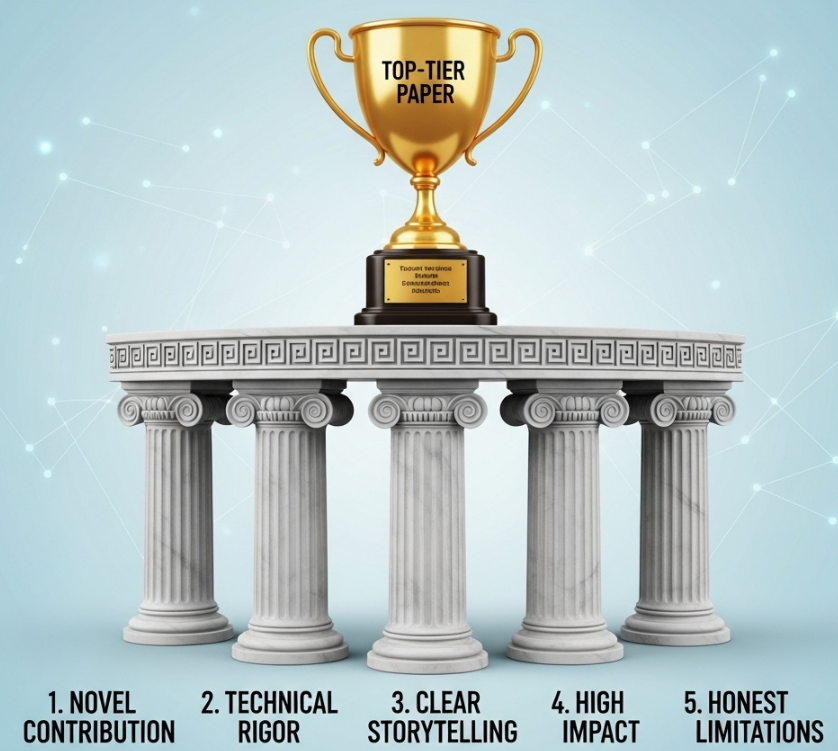

109 views||Release time: Sep 29, 2025
In every academic field, there is a small, elite group of conferences considered to be "top-tier" . These are the venues—like NeurIPS in AI, CHI in human-computer interaction, or CVPR in computer vision—where acceptance rates are brutally low and the published work defines the future of the field.

Getting a paper accepted into one of these conferences is a significant achievement. But what separates these accepted papers from the thousands of others that are rejected? It's more than just good research; it's a combination of specific, high-level traits that signal excellence to the world's leading experts.
This guide breaks down the five essential characteristics of a top-tier conference paper.
This is the absolute, non-negotiable heart of a top-tier paper. The research must present a genuinely new contribution to the field. This can take several forms:
A fundamentally new idea or technique: It introduces a completely new way of thinking about a problem.
A breakthrough result: It solves a long-standing problem that the community has struggled with.
A surprising discovery: The findings are counter-intuitive and challenge existing assumptions.
A rigorous, large-scale study that definitively answers an important question.
A top-tier paper is not just an incremental improvement on existing work (e.g., a 1% performance boost on a standard benchmark). It must push the boundaries of knowledge in a meaningful way. The first question a reviewer asks is, "What is the new contribution here, and is it important?"
A brilliant idea is worthless without flawless execution. Top-tier papers are subjected to intense scrutiny by the best minds in the field, and they must hold up. Technical rigor means:
Sound Methodology: The experimental design is robust, the theoretical proofs are correct, and the user studies are well-designed.
Convincing Evidence: Every claim made in the paper is backed by strong, unambiguous evidence from the results.
Thorough Evaluation: The work is compared against the strongest and most relevant state-of-the-art baselines. The authors perform deep analysis, including ablation studies (analyzing the contribution of each component of their system) to demonstrate why their method works.
There can be no shortcuts or weaknesses in the technical execution. The work must be scientifically sound and replicable.
It's not enough to have a great idea; you must communicate it with masterful clarity. A top-tier paper is also a masterpiece of scientific storytelling. This includes:
A Compelling Introduction: The introduction doesn't just state the topic; it frames the problem, explains why it's critical, and clearly articulates the paper's specific contributions, convincing the reader to care.
A Logical Narrative Flow: The paper reads like a coherent story, guiding the reader effortlessly from the problem and related work to the proposed solution and its evaluation.
Flawless Writing: The language is precise, concise, and unambiguous. There are no grammatical errors or typos. The presentation is professional and respects the reader's time.
Top-tier conferences want to publish papers that will be read, cited, and built upon by the wider community for years to come. The research often has:
Broad Applicability: It addresses a problem that is important to a large segment of the conference's audience, not just a tiny, niche sub-field.
The Ability to Open New Doors: The work has the potential to inspire new research directions and new questions. It's not a dead end; it's a starting point.
Reviewers will often ask, "Who will be interested in this work?" For a top-tier paper, the answer is, "A lot of people."
Paradoxically, one of the hallmarks of a strong paper is a thoughtful and honest discussion of its own limitations. This demonstrates a deep understanding of the research context and shows intellectual maturity. Instead of claiming their method solves everything, top authors are upfront about the boundary conditions, potential failure cases, or unanswered questions. This builds trust and credibility with reviewers.
Conclusion
In summary, a top-tier conference paper is a rare synthesis of a significant new idea, impeccable technical execution, brilliant communication, high potential impact, and intellectual honesty. While the standard is incredibly high, understanding these core traits is the first step toward producing work that not only gets published but truly advances the field.